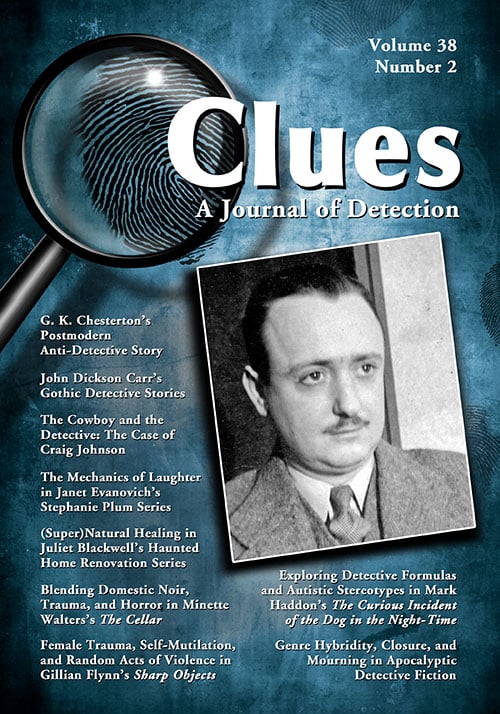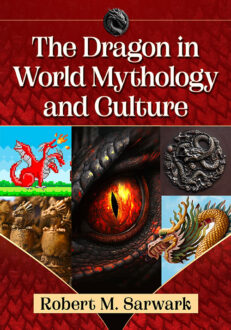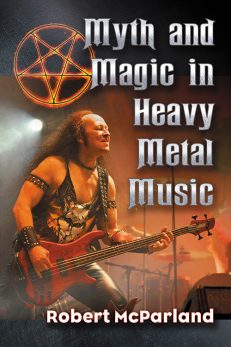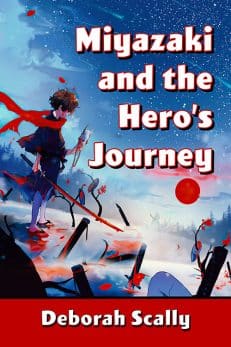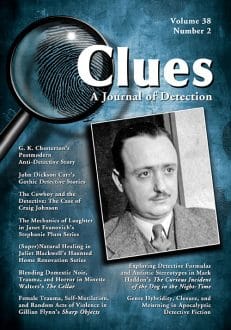Clues: A Journal of Detection, Vol. 38, No. 2 (Fall 2020)
Print Back Issue$30.00
In stock
About the Book
BACK ISSUE
This is a single back issue only. To order a current subscription, or for more information, please visit the journal’s web page at CluesJournal.com. Back issues from earlier volumes of Clues are available for order subject to availability. Also, single issues of the current volume may be ordered one at a time. Individuals may order back issues directly from our online catalog, and the charge for individuals is $30 (excluding postage). Issues from Volume 33 to the present are also available in ebook format on Kindle, Nook and Google Play. The charge for single issues for institutions is $75 per issue (excluding postage). If your institution requires a back issue, please contact us to order at the appropriate rate.
About the Author(s)
Bibliographic Details
Executive Editor Janice M. Allan
Managing Editor Elizabeth Foxwell
Consulting Editor Margaret Kinsman
Format: softcover (7 x 10), back issue
Pages: 130
Bibliographic Info:
Copyright Date: 2020
ISSN 0742-4248
Imprint: McFarland
Table of Contents
Theme Issue: Genre-B(l)ending—Crime’s Hybrid Forms
Guest Editor: Maurizio Ascari
Introduction: Make It New, but Don’t Forget (Maurizio Ascari) 5
The guest editor of Clues vol. 38, no. 2, on genre b(l)ending discusses its Table of Contents, including articles on Juliet Blackwell, John Dickson Carr,
G. K. Chesterton, James Church, Janet Evanovich, Gillian Flynn, Mark
Haddon, Hanna Jameson, Craig Johnson, Minette Walters, and Ben H. Winter.
Golden Age Cross-Pollinations
G. K. Chesterton’s Postmodern Anti-Detective Story: Generic Innovation and Transgression in “The White Pillars Murder” (Nils Clausson) 13
G. K. Chesterton’s undervalued story “The White Pillars Murder” anticipates the postmodern anti-detective story in the way it transgresses the conventions of the Holmes-style analytic detective story and subversively introduces political critique into a genre, the Golden Age country house mystery, widely regarded as either apolitical or conservative.
Murder, Mayhem, and Madness: John Dickson Carr’s Gothic Detective Stories (Stefano Serafini) 23
This essay investigates the contact zones between gothic and detective fiction within the early work of the significant yet largely neglected author John Dickson Carr. By revealing the transgressive and contaminated character of his narratives, this essay also provides a more nuanced picture of interwar crime-writing, the literary boundaries of which were constantly violated and renegotiated.
Transformative Settings
The Cowboy and the Detective: The Case of Craig Johnson (Antoine Dechêne) 33
This essay focuses on Craig Johnson’s charismatic protagonist Walt Longmire, the county sheriff of Absaroka, Wyoming. A cowboy-detective par excellence, Longmire embodies the interrelationship between the Western and detective fiction while offering a good example of “glocal literature”—that is, a form of literature that is both global and local.
James Church’s A Corpse in the Koryo and His Inspector O Series: A Noir/Spy Thriller Hybrid Set in North Korea (David C. Wright Jr.) 40
Analysis of A Corpse in the Koryo, the first book in the Inspector O series by James Church, shows that this series featuring a North Korean detective constitutes a successful genre hybrid: a hard-boiled detective thriller, à la Raymond Chandler, combined with a spy novel in the style of John le Carré.
Ironic Reinventions
Laughter in Crime: The Mechanics of Laughter in Janet Evanovich’s Stephanie Plum Series (Solange Garnier-Fox) 50
The author examines how Janet Evanovich’s Stephanie Plum series works alongside hard-boiled and soft-boiled conventions to create a hybrid formula of genres seemingly at odds with detective fiction. By infusing romance, adventure, and comedy in the detective genre, Evanovich creates a new female agency and rewrites US founding myths of the pursuit of happiness and self-realization.
(Super)Natural Healing in Juliet Blackwell’s Haunted Home Renovation Series (Rachel Schaffer) 60
The ability of Juliet Blackwell’s accidental sleuth, builder Mel Turner, to communicate with ghosts make her an effective healer of historic homes and their past and present residents. Blackwell’s series effectively combines elements of the mystery and supernatural genres to showcase Mel’s ability to tell the stories and heal the trauma of both the living and the dead.
Dark Domesticities
“Darkness Speaks”: Blending Domestic Noir, Trauma, and Horror in Minette Walters’s The Cellar (Charlotte Beyer) 69
When Minette Walters’s The Cellar was published in 2015, reviewers expressed shock and abhorrence at the novel’s graphic portrayals. The author’s analysis focuses on the novel’s trauma narrative and use of domestic noir to critique the patriarchal family, and interrogates the trafficking victim’s experience through horror and the paranormal.
Dirty Pretty Things: Female Trauma, Self-Mutilation, and Random Acts of Violence in Gillian Flynn’s Sharp Objects (Malinda K. Hackett) 80
The author examines Gillian Flynn’s novel Sharp Objects within the context of domestic noir and trauma theory. Drawing on the work of both Cathy Caruth and Ann Whitehead, the author contends that the women who inhabit the domestic space of Flynn’s narrative partake in performative acts of pathology to reject notions of idealized femininity, beauty, and motherhood.
Focus on Form
Rethinking Genre Conventions: Exploring Detective Formulas and Autistic Stereotypes in Mark Haddon’s The Curious Incident of the Dog in the Night-Time (Soohyun Cho) 90
This essay explores common cultural/social stereotypes about autism, focusing on their intersection with archetypal detective formulas. Focusing on Mark Haddon’s The Curious Incident of the Dog in the Night-Time, it explores how Christopher Boone embodies key traits narratively associated with Sherlock Holmes’s unique mind. This use of a stereotypical characterization enables readers to engage with diverse minds.
Seeking a Solution to the End of the World: Genre Hybridity, Closure, and Mourning in Apocalyptic Detective Fiction
sarah france 100
This essay looks to Ben H. Winters’s The Last Policeman (2012) and Hanna Jameson’s The Last (2019) as examples of apocalyptic detective fiction. Here, the generic expectation of detective closure is frustrated by a secular apocalypse, articulating an attempt but ultimately a failure to adequately mourn a future apocalyptic event.
reviews
Sheldon Goldfarb. Sherlockian Musings: Thoughts on the Sherlock Holmes Stories (Lynnette Porter) 110
Nathan Ashman. James Ellroy and Voyeur Fiction (Daniel Fuller) 111
Jesper Gulddal, Stewart King, and Alistair Rolls, eds. Criminal Moves: Modes of Mobility in Crime Fiction (Fred Isaac) 113
Deborah E. Barker and Theresa Starkey, eds. Detecting the South in Fiction, Film & Television (Sarah D. Fogle) 114
Kinohi Nishikawa. Street Players: Black Pulp Fiction and the Making of a Literary Underground (Cynthia S. Hamilton 116
Laura James. The Beauty Defense: Femmes Fatales on Trial (Zannika R. P. Deutsch) 117
Martina Vránová, Zénó Vernyik, and Dávid Levente Palatinus, eds. Crime and Detection in Contemporary Culture (Daisy Cowley ) 119
Clues Index, Volume 38 121
Clues CFP—Historical Crime Fiction 129
Author Guidelines are on page 130.
Book Reviews & Awards
- “Clues is a must-have for readers and writers of crime fiction. Scholarly, thought-provoking, wide-ranging in its topics, Clues covers the crime and thriller map.”—Sara Paretsky
- “A. Conan Doyle, notoriously resentful of Sherlock Holmes’s success, liked to scorn ‘police romances’ as less significant and worthy of his talents than his other literary work. If he could have read Clues, the thinking mystery reader’s journal, he would surely have felt differently—and learned much he never realized himself about even his own landmark contribution to the genre, from which so much else by others has flowed.”—Jon Lellenberg, U.S. agent for the Arthur Conan Doyle estate
- “I love reading Clues. Every issue provides thought-provoking, well-researched articles. The variety and scope of the material found in Clues makes an unparalleled, ongoing contribution to our understanding of the role of crime fiction in our culture, and the genre’s reflection of its time and society.”—Jan Burke, Edgar-winning author of The Messenger (2009)
- “Clues is an important journal. It carries the torch of tradition that is the backbone of detective fiction. It goes below the surface and gets to the heart of what makes the genre so fascinating and valid today”—Michael Connelly, author of the Harry Bosch novels, including The Overlook (2007)
- “For erudite and fascinating truths about mysteries, follow the clues to Clues, the scholarly journal that is an essential resource for every serious student of the mystery”—Carolyn Hart, author of Death Walked In (2008)
- “With scholarship ranging from Poe to Peters, nothing beats Clues”—Joan Hess, author of Mummy Dearest (2008)

